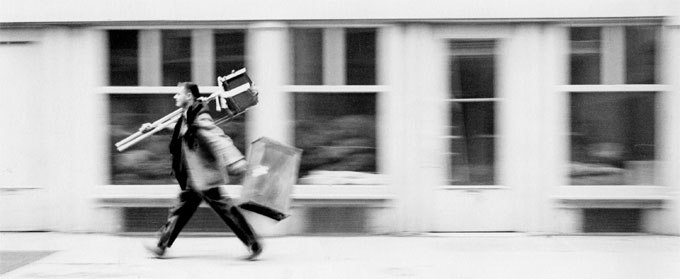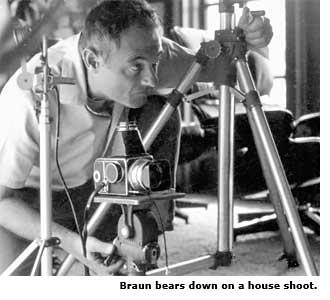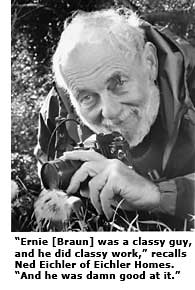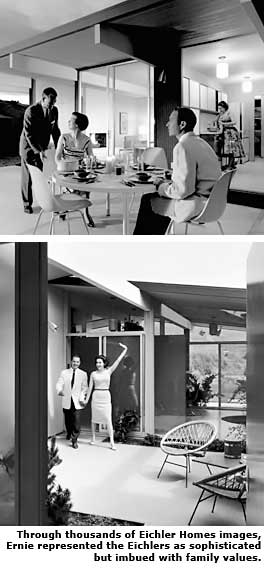Touching the Soul: In Memoriam, Ernie Braun (1921-2010)


Toddlers playing with toy trains or blocks while their moms look fondly on. Young marrieds, holding hands, and waving happily—apparently at the cameraman—as they stroll into their new home.
The image that the world-at-large has of the Eichler homes is the work largely of Ernie Braun, a slender, soft-spoken man with piercing blue eyes and an ever-present pipe, who from 1954 until 1968 served as Joe Eichler's chief photographer.
Braun, who died March 23 [2010] at age 88, helped define the Eichler lifestyle as sophisticated but imbued with family values, and suggested what sorts of people should consider an Eichler home—those with a sense of flair.
"Ernie was a classy guy and he did classy work. He was an easy guy to work with, which a lot of photographers were not," said Ned Eichler, Joe's son and the company's chief of marketing. "Architectural photography was his field, and he was damn good at it."
Braun became one of the top architectural photographers in Northern California in the 1950s and 1960s. Like Julius Shulman, but unlike most of his colleagues, Braun believed in bringing people into his photographs—a controversial decision at the time. "The stupid architects had never seen a thing like that," Braun said in a 2008 interview, "and they didn't want people to spend all their time looking at pretty girls instead of their architecture."
In memoriam
The passing of photographer Ernie Braun leaves a big hole in the hearts of many. For us at the Eichler Network, he was a dear friend for the past 15 years. He touched us not only with his rich, beautiful photographs, but with his kind, gentle nature and honest approach to life.
Braun photographed architecture and landscapes by most of the area's leading modernists, including Wurster, Bernardi & Emmons, Lawrence Halprin, Joseph Allen Stein, Gardner Dailey, and Roger Lee. He was one of the first photographers at Sea Ranch, and contributed photos to 'Sunset,' 'Better Homes and Gardens,' 'Architectural Forum,' and other magazines.
Eichler Homes was among his favorite accounts. "I loved the artistic freedom the Eichler staff and their public relations firms would give me with assignments—to put people in the scenes, and if I wanted to, to have fun staging a pillow fight in a bedroom," Braun recalled.
But Braun never considered himself primarily an architectural photographer. "I like variety," he said. "I've never considered myself an expert in one thing."
"If it's a beautiful design," Braun said, "I'm interested in photographing it no matter what the subject is."

In later years, Braun worked for corporations and non-profit groups, including Hewlett-Packard and the Trust for Public Land, often producing photographs for annual reports. Braun shot photos on every continent. And in the mid-1960s he found what he considered his true calling—nature photography.
Braun came from a background that was both artistic and spiritual. His father, Maurice Braun, was one of America's leading Impressionist painters, and both his parents were active in the Theosophical Society, a philosophy that blends Eastern and Western mysticism.
Braun, who grew up in San Diego, went to a Theosophist boarding school throughout his childhood, imbibing Theosophy's focus on nature and the arts. Braun's wife, Sally, was the daughter of a leading figure in the movement. Braun remained a Theosophist throughout his life, though not active with the society. He contributed photos to its magazine through the 1990s.
Braun began taking photos at age six after an uncle gave him a camera. He and a friend built an enlarger when he was a teenager. He studied journalism at San Diego State, where he shot photos for the yearbook. Braun later studied photography at the Art Center College of Design in Southern California, but never got a college degree.
During World War II, Braun served in the Signal Corps as a combat photographer. "I never wanted to be in the war," he said. "I'm totally anti-war." Braun traveled through France, Germany, and Belgium and accompanied Allied troops entering the Death Camps. "I observed closely man's incredible inhumanity to man," he recalled.





